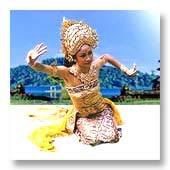At the beginning of 7th century, a Balinese prince, the great Erlangga, became the king of a Javanese in east Java, the Kingdom of Daha. His mother, Mahendradatta, was a Javanese princess who ruled Bali with her Balinese husband, Dharmodayana, until the husband, suspecting her of practicing evil magic, exiled her to the forest.
When Erlangga’s father died, leaving Mahendradatta as a rangda or a widow, she conspired to use her band of pupils trained in the black arts to destroy Erlangga’s kingdom. Her chief grudge against Erlangga because of fancied insults to her beautiful daughter, Ratna Menggali – the noblemen of Daha had refused her in marriage for fear of her mother’s evil reputation and the failure of Airlangga to prevent his father ( Dharmodayana) to marry again.
Calonarang (Erlangga’s mother who practising evil magic) went with her pupils to the cemetery and they prayed and danced in honor of Durga Bhairawa, the deity of black magic, to help them destroy Daha. The goddess appeared and danced with them, granting her permission, warning the witch, however, to preserve the center of the kingdom untouched. The witches danced at the crossroads and soon people fell in great numbers.
Discovering the cause of the epidemic, Erlangga ordered his soldiers to go and kill the witch. They stole into her house while she slept and stabbed her in the heart , but Calonarang awoke unhurt and consumed the daring soldiers with her own fire. The witch went once more into the cemetery and danced with her pupils, dug out corpses, cutting them into pieces, eating the members, drinking the blood, and wearing the entrails as necklaces. Durga Bhairawa appeared again and joined in the bloody banquet, but warned Calonarang to be careful. The witches danced once more at the crossroads and the dreadful epidemic ravaged the land, the vassals of Erlangga died before they could even bury the the corpses they bore to the cemeteries.
The desperate king sent for Mpu Bharada, the holy man from Lemah Tulis, the only living being who could vanquish the witch. Mpu Bharada planned his campaign carefully. He sent Bahula, his young assistant, to ask for the witch daughter’s in marriage. Highly flattered, the mother gave her consent and after a happy and passionate honeymoon, Bahula learned from his wife the secret of Calonarang’s power. The possession of a little magic book which he stole and turned over to his master. The holy man copied it and had it returned before the disappearance could be noticed. The book was a manual of righteousness and had to be read backwards. The holy man was then able to restore life to those victims whose bodies had not yet decayed. Armed with the new knowledge, he accused the witch of her crimes, but she challenged him by setting an enormous Banyan tree on fire by a single look of her fiery eyes. Bharada foiled the enraged witch by restoring the tree, and she turned her fire against the holy man. Unmoved, he killed her with one of her own mantras, but she died in her monstrous form and Bharada, to absolve her of her crimes and enable her to atone for them, revived her, gave her human appearance, and then killed her again. (BALIwww)












